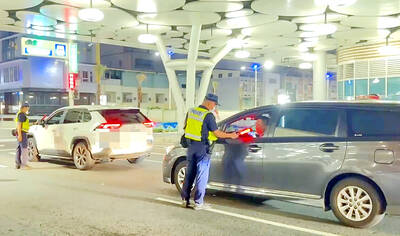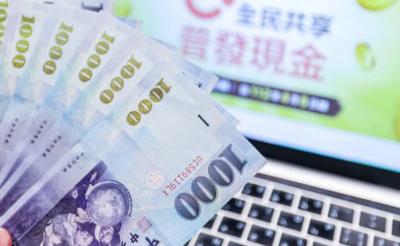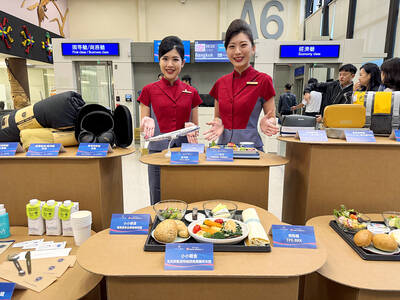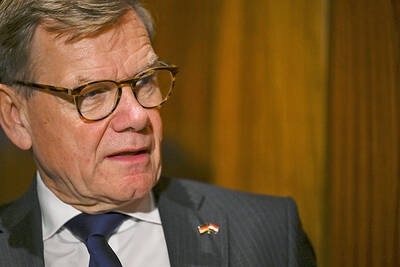The Tourism Bureau said the nation has been generating a tourism revenue surplus since 2011, adding that the increase of Chinese tourists did not push Japanese tourists away.
The bureau was responding to reports by the Chinese-language Liberty Times (the Taipei Times’ sister newspaper) that cited Providence University professor Hwang Cheng-tsung (黃正聰) as saying that tourism benefits should not be viewed only from the aspect of revenue, adding that while Taiwan takes pride in having 8 million visitor arrivals last year, it fails to see that every year, Taiwanese make 10 million tourist visits overseas.
Another story in the Liberty Times cited a report published by the Legislative Yuan’s Budget Center that asked the government to restrict the quota reserved for Chinese tourists and enhance campaigns to attract tourists from countries with greater spending power, such as Japan.
The bureau said that Taiwan has enjoyed a surplus in tourism revenue since 201l, when the income brought by inbound tourists exceeded the expenditure of outbound tourists by NT$28.1 billion (US$936 million). Last year’s surplus was smaller, as tourism revenue topped NT$366.8 billion, while the expenditure of outbound tourists reached NT$366.3 billion, but comparing the amount spent by outbound tourists and by inbound tourists can be misleading, it said.
This is because expenditure of outbound tourists includes the money spent on flight tickets, which accounts for about half or one-third of travel expenditures, while the revenue brought by inbound tourists does not include money spent on flight tickets, it said.
Regarding the cross-strait tourism market, the ratio between Chinese tourists in Taiwan and Taiwanese tourists in China dropped from 0.95 in 2008 to 0.44 last year, statistics from the bureau showed.
Meanwhile, the deficit in the cross-strait tourism market shrank from US$4.151 billion in 2008 to US$726 million last year. The deficit turned into surplus in the first half of this year, when Chinese tourists brought US$3.63 billion in revenue. By contrast, the expenditure of Taiwanese tourists traveling domestically reached US$3.06 billion.
The bureau said that about 50 percent of Taiwanese visitors to China are Taiwanese businesspeople, who tend to go in and out of China multiple times throughout the year. About 75 percent of Chinese visitors to Taiwan came for tourism purposes only, it said.
The bureau denied that Japanese tourists were pushed out by the large number of Chinese tourist arriving in the nation.
Statistics from the bureau indicated that about 783,000 Japanese tourists visited between January and June this year, about 18.5 percent more than in the same period last year, it said.
The Japan Association of Travel Agents has projected year-on-year growth of 40 percent in the third quarter this year, the bureau said. The bureau also said that the devaluation of the yen and the rise in Japan’s sales tax had discouraged Japanese from traveling abroad and spending while traveling last year.
The bureau said the number of South Korean visitors grew by 79.81 percent between January and June this year. Arrivals from Malaysia increased by 27 percent in that time, while those from Hong Kong and Macau rose by 18.55 percent. Double-digit growth was also seen in arrivals from Europe, North America, New Zealand and Australia.

TRAFFIC SAFETY RULES: A positive result in a drug test would result in a two-year license suspension for the driver and vehicle, and a fine of up to NT$180,000 The Ministry of Transportation and Communications is to authorize police to conduct roadside saliva tests by the end of the year to deter people from driving while under the influence of narcotics, it said yesterday. The ministry last month unveiled a draft of amended regulations governing traffic safety rules and penalties, which included provisions empowering police to conduct mandatory saliva tests on drivers. While currently rules authorize police to use oral fluid testing kits for signs of drug use, they do not establish penalties for noncompliance or operating procedures for officers to follow, the ministry said. The proposed changes to the regulations require

The Executive Yuan yesterday announced that registration for a one-time universal NT$10,000 cash handout to help people in Taiwan survive US tariffs and inflation would start on Nov. 5, with payouts available as early as Nov. 12. Who is eligible for the handout? Registered Taiwanese nationals are eligible, including those born in Taiwan before April 30 next year with a birth certificate. Non-registered nationals with residence permits, foreign permanent residents and foreign spouses of Taiwanese citizens with residence permits also qualify for the handouts. For people who meet the eligibility requirements, but passed away between yesterday and April 30 next year, surviving family members

China Airlines Ltd (CAL) yesterday morning joined SkyTeam’s Aviation Challenge for the fourth time, operating a demonstration flight for “net zero carbon emissions” from Taiwan Taoyuan International Airport to Bangkok. The flight used sustainable aviation fuel (SAF) at a ratio of up to 40 percent, the highest proportion CAL has achieved to date, the nation’s largest carrier said. Since April, SAF has become available to Taiwanese international carriers at Taipei International Airport (Songshan airport), Kaohsiung International Airport and Taoyuan airport. In previous challenges, CAL operated “net zero carbon emission flights” to Singapore and Japan. At a ceremony at Taoyuan airport, China Airlines chief sustainability

‘ONE CHINA’: A statement that Berlin decides its own China policy did not seem to sit well with Beijing, which offered only one meeting with the German official German Minister for Foreign Affairs Johann Wadephul’s trip to China has been canceled, a spokesperson for his ministry said yesterday, amid rising tensions between the two nations, including over Taiwan. Wadephul had planned to address Chinese curbs on rare earths during his visit, but his comments about Berlin deciding on the “design” of its “one China” policy ahead of the trip appear to have rankled China. Asked about Wadephul’s comments, Chinese Ministry of Foreign Affairs spokesman Guo Jiakun (郭嘉昆) said the “one China principle” has “no room for any self-definition.” In the interview published on Thursday, Wadephul said he would urge China to